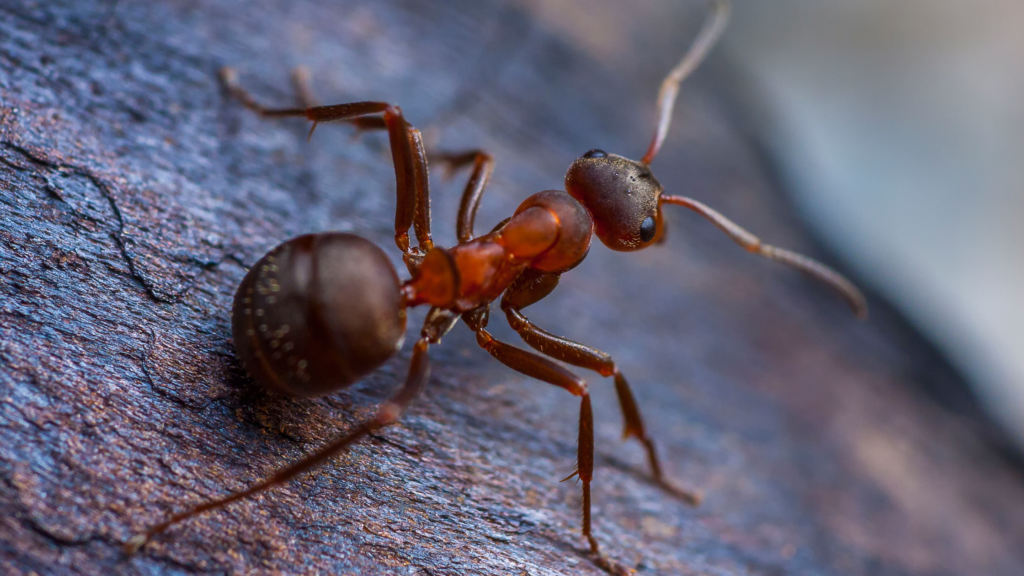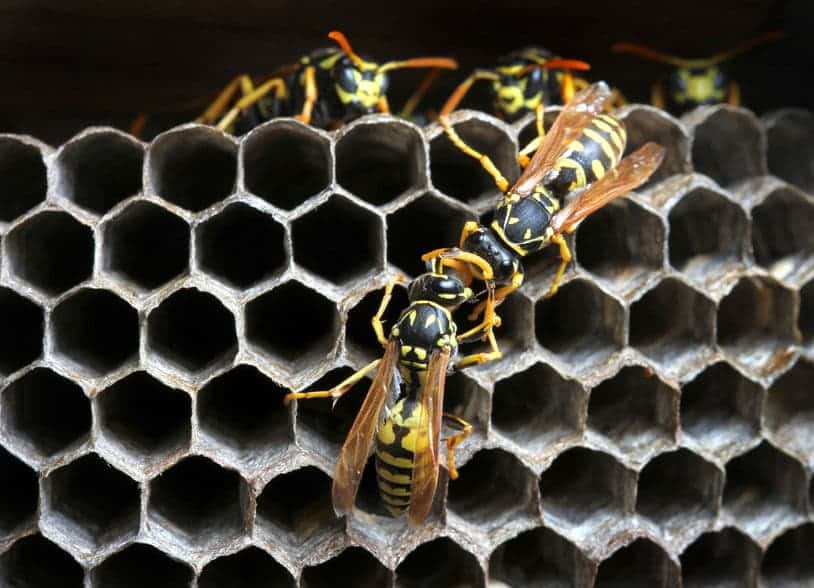Beetles can come in a variety of shapes and sizes, but beetles when spotted, perhaps best fit the notion of what a “bug” is. Beetles typically are not harmful to humans, but they can do damage and become a nuisance. Below are just a sampling of some of the beetles that you may encounter around your home or yard.
Ambrosia Beetle
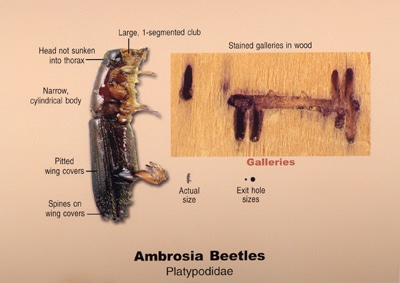
HABITAT/WOOD PREFERENCE
The beetles excavate tunnels in dead trees in which they cultivate fungal gardens, their sole source of nutrition.
BIOLOGY AND BEHAVIOR
Associated with a fungus that stains the excavated galleries. Can cause a fungal infection lethal to the tree.
DISTRIBUTION
Common and problematic in the mid-Atlantic and southern United States
Deathwatch Beetle
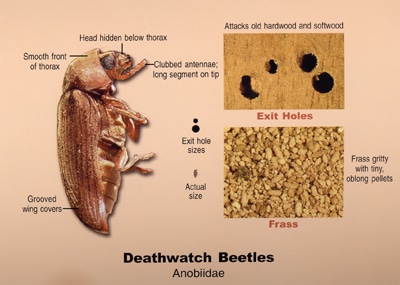
HABITAT/WOOD PREFERENCE
This beetle’s larva is very soft, yet it can bore its way through wood, through which it is able to digest using a number of enzymes in its alimentary canal provided that the wood has experienced prior fungal decay (old wood).
BIOLOGY AND BEHAVIOR
Adults of E. peltata emerge between June and August. Larvae take one to two years to develop.
DISTRIBUTION
Found throughout the eastern United States, especially in the southeastern states
Engraver Beetle
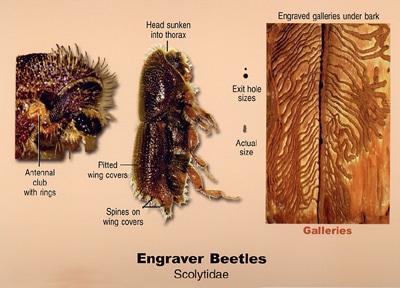
HABITAT/WOOD PREFERENCE
This beetle attacks small diameter ponderosa, Jeffrey and lodgepole pines throughout the trees range and may occasionally attack other pine species.
BIOLOGY AND BEHAVIOR
May infest live trees in sufficient numbers to kill them.
DISTRIBUTION
Southern United States
True Powderpost Beetle
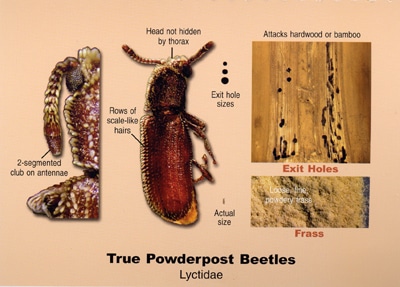
HABITAT/WOOD PREFERENCE
Powderpost beetles feed on deciduous trees, including certain hardwoods or softwoods depending on the species. Some hardwoods are naturally immune if they have low starch content or if their pore diameters are too small for the female beetle’s ovipositor to lay her eggs in.
BIOLOGY AND BEHAVIOR
Females lay eggs only in wood with available pores (finished wood surfaces are immune). Larvae take two to nine months to develop. Pupation lasts from twelve days to three weeks. Adults are attracted to light.
DISTRIBUTION
Common in the southeastern United States
Grain Beetle
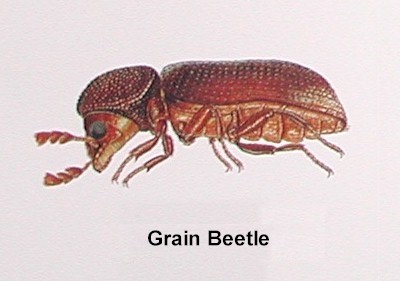
HABITAT/WOOD PREFERENCE
Adults find their way into stored grains, flour, sugar, nuts and other dry material of plant origin through cracks and crevices of imperfectly sealed containers. They are incapable of attacking sound grain kernels and often occur in food previously infested by other stored product pests. This pest may be found infesting dry goods, crawling around kitchen surfaces and occasionally underneath tree bark.
BIOLOGY AND BEHAVIOR
The adult beetle is a small (1/10 inch long), very flattened and brown with the segment just behind the head (pronotum) having characteristic “sawtoothed” outer margins, bearing six “teeth” on each side. Development from egg to egg occurs in 27 to 375 days. Four to six generations can occur annually.
DISTRIBUTION
Worldwide in distribution
Spider Beetle
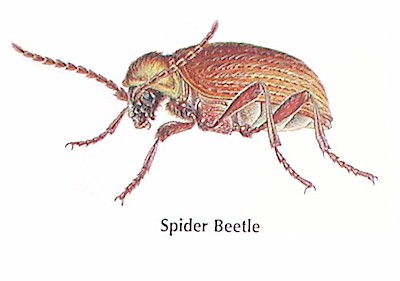
HABITAT/WOOD PREFERENCE
Spider beetles are primarily scavengers with many species feeding on both plant and animal origin materials. They feed on grain products, seeds, dried fruits, meats, fish meal, wool, hair, feathers, skins, drugs, roots, rodent droppings, insect and other animal carcasses, and plant and museum specimens. Besides being founds in human food, warehouses, food-handling establishments, granaries, mills, museums, and homes, they are also found in the nests of bees, wasps, birds, mammals and in vat caves and on dry carrion.
BIOLOGY AND BEHAVIOR
Relatively few eggs, maybe up to 100 but often fewer, are laid in, on or near larval food material. Many species are active only at night, hiding in cracks, crevices, and voids during daylight. Some can fly, others cannot.
DISTRIBUTION
Worldwide but are more common in temperate regions, which includes the U.S.
Old House Borer Beetle
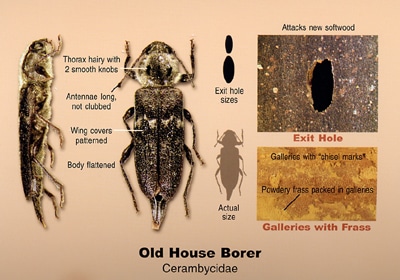
HABITAT/WOOD PREFERENCE
Old house borer is one of the only species of Cerambycidae that infests dead wood. This species prefers relatively new softwood timbers.
BIOLOGY AND BEHAVIOR
Adults of H. bajulus emerge between June and August. Larvae take two to ten years to develop.
DISTRIBUTION
Found coastally from Florida to Maine, and west to Michigan and Texas
Confused Flour Beetle
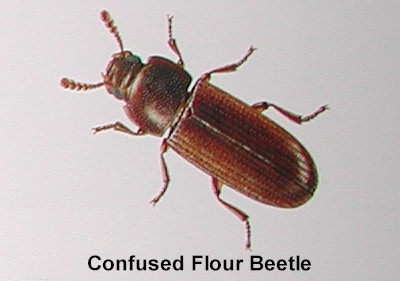
HABITAT/WOOD PREFERENCE
While confused flour beetles cannot feed on whole, undamaged grain, they are often found in large numbers in infested grains, feeding on broken grain, grain dust, and other household food items such as flour, rice, dried fruit, nuts, and beans. Both types of beetles are often found not only in infested grains, but in crevices in pantries and cabinet, as well. Damage to food is caused somewhat by the beetles’ feeding, but also by their dead bodies, fecal pellets, and foul-smelling secretions. In addition to creating a foul odor, the beetles’ presence encourages the growth of mold.
BIOLOGY AND BEHAVIOR
The confused flour beetle female deposits about 300-500 clear-white eggs on or among food materials in cracks, in bags, or through the mesh of sacks containing food. They are attracted to light even though they apparently do not fly.
DISTRIBUTION
Found worldwide in cooler climates and in the U.S. it is more abundant in the northern states
Larder Beetle
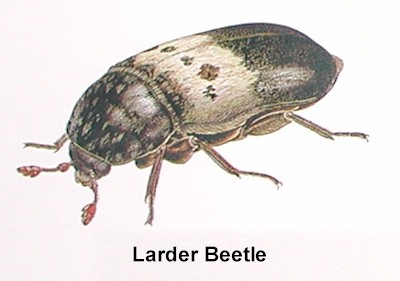
HABITAT/WOOD PREFERENCE
The adults and larvae feed on all kinds of animal products such as dried fish, ham, bacon, meats, cheese, dried pet food, and dried museum specimens including insects, hides, feathers, horn and hair
BIOLOGY AND BEHAVIOR
Adult females lay their eggs on suitable larval food or in cracks and crevices where such food is stored.
DISTRIBUTION
Throughout the U.S. and the world
Sawtoothed Beetle
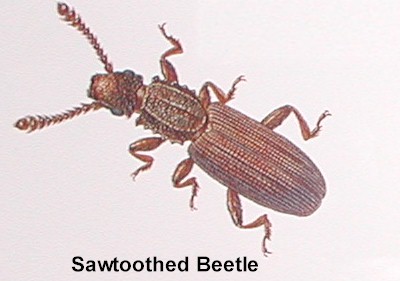
HABITAT/WOOD PREFERENCE
Adults find their way into stored grains, flour, sugar, nuts and other dry material of plant origin through cracks and crevices of imperfectly sealed containers. They are incapable of attacking sound grain kernels and often occur in food previously infested by other stored product pests. This pest may be found infesting dry goods, crawling around kitchen surfaces and occasionally underneath tree bark.
BIOLOGY AND BEHAVIOR
The adult beetle is a small (1/10 inch long), very flattened and brown with the segment just behind the head (pronotum) having characteristic “sawtoothed” outer margins, bearing six “teeth” on each side. Development from egg to egg occurs in 27 to 375 days. Four to six generations can occur annually.
DISTRIBUTION
Worldwide in distribution
Pest Control Library | Ants | Beetles | Cockroaches | Termites | Other Pests

